陕西科技大学:《包装技术基础 Fundamentals of Packaging Technology》课程PPT教学课件(英文版)Lesson 15 Seven Steps for Cushioned Package Development 第15课 缓冲包装设计七步法
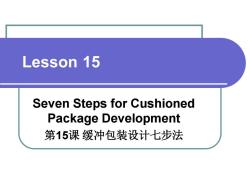
Lesson 15 Seven Steps for Cushioned Package Development 第15课 缓冲包装设计七步法
Lesson 15 Seven Steps for Cushioned Package Development 第15课 缓冲包装设计七步法
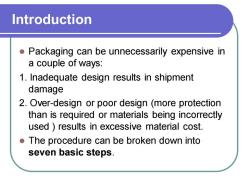
Introduction ⚫ Packaging can be unnecessarily expensive in a couple of ways: 1. Inadequate design results in shipment damage 2. Over-design or poor design (more protection than is required or materials being incorrectly used ) results in excessive material cost. ⚫ The procedure can be broken down into seven basic steps
Introduction ⚫ Packaging can be unnecessarily expensive in a couple of ways: 1. Inadequate design results in shipment damage 2. Over-design or poor design (more protection than is required or materials being incorrectly used ) results in excessive material cost. ⚫ The procedure can be broken down into seven basic steps
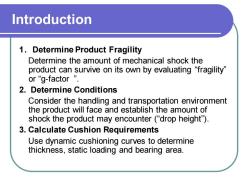
Introduction 1.Determine Product Fragility Determine the amount of mechanical shock the product can survive on its own by evaluating “fragility” or “g-factor ”. 2. Determine Conditions Consider the handling and transportation environment the product will face and establish the amount of shock the product may encounter (“drop height”). 3. Calculate Cushion Requirements Use dynamic cushioning curves to determine thickness, static loading and bearing area
Introduction 1.Determine Product Fragility Determine the amount of mechanical shock the product can survive on its own by evaluating “fragility” or “g-factor ”. 2. Determine Conditions Consider the handling and transportation environment the product will face and establish the amount of shock the product may encounter (“drop height”). 3. Calculate Cushion Requirements Use dynamic cushioning curves to determine thickness, static loading and bearing area
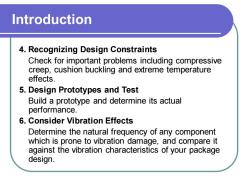
Introduction 4. Recognizing Design Constraints Check for important problems including compressive creep, cushion buckling and extreme temperature effects. 5. Design Prototypes and Test Build a prototype and determine its actual performance. 6. Consider Vibration Effects Determine the natural frequency of any component which is prone to vibration damage, and compare it against the vibration characteristics of your package design
Introduction 4. Recognizing Design Constraints Check for important problems including compressive creep, cushion buckling and extreme temperature effects. 5. Design Prototypes and Test Build a prototype and determine its actual performance. 6. Consider Vibration Effects Determine the natural frequency of any component which is prone to vibration damage, and compare it against the vibration characteristics of your package design

Introduction 7. Monitor Performance Monitor the performance of your design to determine when internal changes in the design might alter the requirements for package performance. ( Another way for cushion design: Five steps for package cushion design ) 动画
Introduction 7. Monitor Performance Monitor the performance of your design to determine when internal changes in the design might alter the requirements for package performance. ( Another way for cushion design: Five steps for package cushion design ) 动画

Step 1 Determine Product Fragility ⚫ Fragility is normally expressed in units of “g’s” and indicates the maximum deceleration the product can withstand without being damaged. The more fragile a product is, the lower its g-factor(Table 15.1)
Step 1 Determine Product Fragility ⚫ Fragility is normally expressed in units of “g’s” and indicates the maximum deceleration the product can withstand without being damaged. The more fragile a product is, the lower its g-factor(Table 15.1)
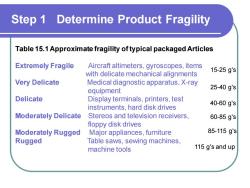
Step 1 Determine Product Fragility Table 15.1 Approximate fragility of typical packaged Articles Extremely Fragile Aircraft altimeters, gyroscopes, items with delicate mechanical alignments Very Delicate Medical diagnostic apparatus, X-ray equipment Delicate Display terminals, printers, test instruments, hard disk drives Moderately Delicate Stereos and television receivers, floppy disk drives Moderately Rugged Major appliances, furniture Rugged Table saws, sewing machines, machine tools 15-25 g's 25-40 g's 40-60 g's 85-115 g's 60-85 g's 115 g's and up
Step 1 Determine Product Fragility Table 15.1 Approximate fragility of typical packaged Articles Extremely Fragile Aircraft altimeters, gyroscopes, items with delicate mechanical alignments Very Delicate Medical diagnostic apparatus, X-ray equipment Delicate Display terminals, printers, test instruments, hard disk drives Moderately Delicate Stereos and television receivers, floppy disk drives Moderately Rugged Major appliances, furniture Rugged Table saws, sewing machines, machine tools 15-25 g's 25-40 g's 40-60 g's 85-115 g's 60-85 g's 115 g's and up
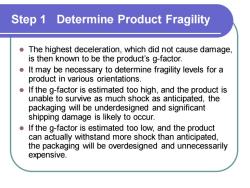
Step 1 Determine Product Fragility ⚫ The highest deceleration, which did not cause damage, is then known to be the product’s g-factor. ⚫ It may be necessary to determine fragility levels for a product in various orientations. ⚫ If the g-factor is estimated too high, and the product is unable to survive as much shock as anticipated, the packaging will be underdesigned and significant shipping damage is likely to occur. ⚫ If the g-factor is estimated too low, and the product can actually withstand more shock than anticipated, the packaging will be overdesigned and unnecessarily expensive
Step 1 Determine Product Fragility ⚫ The highest deceleration, which did not cause damage, is then known to be the product’s g-factor. ⚫ It may be necessary to determine fragility levels for a product in various orientations. ⚫ If the g-factor is estimated too high, and the product is unable to survive as much shock as anticipated, the packaging will be underdesigned and significant shipping damage is likely to occur. ⚫ If the g-factor is estimated too low, and the product can actually withstand more shock than anticipated, the packaging will be overdesigned and unnecessarily expensive
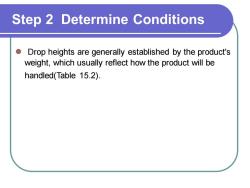
Step 2 Determine Conditions ⚫ Drop heights are generally established by the product's weight, which usually reflect how the product will be handled(Table 15.2)
Step 2 Determine Conditions ⚫ Drop heights are generally established by the product's weight, which usually reflect how the product will be handled(Table 15.2)

Step 2 Determine Conditions Table 15.2 Typical drop heights Weight Range Type of Handling Drop Height Gross Weight in lbs. in inches 0-10 1 person throwing 42 10-20 1 person carrying 36 20-50 1 person carrying 30 50-100 2 person carrying 24 100-250 Light equipment 18 250+ Heavy equipment handling 12+ Note: Palletized products may receive drops of up to six inches
Step 2 Determine Conditions Table 15.2 Typical drop heights Weight Range Type of Handling Drop Height Gross Weight in lbs. in inches 0-10 1 person throwing 42 10-20 1 person carrying 36 20-50 1 person carrying 30 50-100 2 person carrying 24 100-250 Light equipment 18 250+ Heavy equipment handling 12+ Note: Palletized products may receive drops of up to six inches
按次数下载不扣除下载券;
注册用户24小时内重复下载只扣除一次;
顺序:VIP每日次数-->可用次数-->下载券;
- 陕西科技大学:《包装技术基础 Fundamentals of Packaging Technology》课程PPT教学课件(英文版)Lesson 14 Test Method for Product Fragility 第14课 产品脆值试验方法.ppt
- 陕西科技大学:《包装技术基础 Fundamentals of Packaging Technology》课程PPT教学课件(英文版)Lesson 13 Mechanical Shock Theory 第13课 机械冲击理论.ppt
- 陕西科技大学:《包装技术基础 Fundamentals of Packaging Technology》课程PPT教学课件(英文版)Lesson 12 Shock, Vi ation, and Compression 第12课 冲击、振动和受压.ppt
- 陕西科技大学:《包装技术基础 Fundamentals of Packaging Technology》课程PPT教学课件(英文版)Lesson 11 Package Printing 第11课 包装印刷.ppt
- 陕西科技大学:《包装技术基础 Fundamentals of Packaging Technology》课程PPT教学课件(英文版)Lesson 10 Graphic Design in Packaging 第10课 包装中的平面设计.ppt
- 石河子大学:《工业工程基础》课程PPT教学课件(农机专业,2012)第8章 生产率.ppt
- 石河子大学:《工业工程基础》课程PPT教学课件(农机专业,2012)第4章 工作研究概述.ppt
- 石河子大学:《工业工程基础》课程PPT教学课件(农机专业,2012)现场管理.ppt
- 石河子大学:《工业工程基础》课程PPT教学课件(农机专业,2012)第一章 工业工程概述(1.1)工业工程的发展和作用(主讲人:张慧明).ppt
- 石河子大学:《工业工程基础》课程PPT教学课件(农机专业,2012)第一章 工业工程概述(1.2)工业工程定义和内容.ppt
- 石河子大学:《工业工程基础》课程PPT教学课件(农机专业,2012)预定时间标准及模特法.ppt
- 石河子大学:《工业工程基础》课程PPT教学课件(农机专业,2012)操作分析.ppt
- 石河子大学:《工业工程基础》课程PPT教学课件(农机专业,2012)程序分析.ppt
- 石河子大学:《工业工程基础》课程PPT教学课件(机制专业,2011)第四章 工作研究概述.ppt
- 石河子大学:《工业工程基础》课程PPT教学课件(机制专业,2011)第六章 时间研究与工作抽样.ppt
- 石河子大学:《工业工程基础》课程PPT教学课件(机制专业,2011)第五章 方法研究的分析技术.ppt
- 石河子大学:《工业工程基础》课程PPT教学课件(机制专业,2011)第二章 工业工程概述2/2.ppt
- 石河子大学:《工业工程基础》课程PPT教学课件(机制专业,2011)第一章 工业工程概述1/2.ppt
- 石河子大学:《工业工程基础》课程PPT教学课件(工业专业)第4章 现场管理方法.ppt
- 石河子大学:《工业工程基础》课程PPT教学课件(工业专业)第3章 作业测定.ppt
- 陕西科技大学:《包装技术基础 Fundamentals of Packaging Technology》课程PPT教学课件(英文版)Lesson 16 Distribution Packaging 第16课 运输包装.ppt
- 陕西科技大学:《包装技术基础 Fundamentals of Packaging Technology》课程PPT教学课件(英文版)Lesson 17 Computer Aided Packaging System 第17课 计算辅助包装设计系统.ppt
- 陕西科技大学:《包装技术基础 Fundamentals of Packaging Technology》课程PPT教学课件(英文版)Lesson 18 General Overview 第18课 概述.ppt
- 陕西科技大学:《包装技术基础 Fundamentals of Packaging Technology》课程PPT教学课件(英文版)Lesson 19 The Packaging Line 第19课 包装线.ppt
- 陕西科技大学:《包装技术基础 Fundamentals of Packaging Technology》课程PPT教学课件(英文版)Lesson 1 A History of Packaging 第1课 包装发展史.ppt
- 陕西科技大学:《包装技术基础 Fundamentals of Packaging Technology》课程PPT教学课件(英文版)Lesson 20 Filling Systems 第20课 充填灌装系统.ppt
- 陕西科技大学:《包装技术基础 Fundamentals of Packaging Technology》课程PPT教学课件(英文版)Lesson 2 Packaging Functions 第2课 包装的功能.ppt
- 陕西科技大学:《包装技术基础 Fundamentals of Packaging Technology》课程PPT教学课件(英文版)Lesson 3 Paper and Paperboard 第3课 纸与纸板.ppt
- 陕西科技大学:《包装技术基础 Fundamentals of Packaging Technology》课程PPT教学课件(英文版)Lesson 4 Corrugated Fiberboard Boxes 第4课 瓦楞纸板箱.ppt
- 陕西科技大学:《包装技术基础 Fundamentals of Packaging Technology》课程PPT教学课件(英文版)Lesson 5 Metal Containers 第5课 金属容器.ppt
- 陕西科技大学:《包装技术基础 Fundamentals of Packaging Technology》课程PPT教学课件(英文版)Lesson 6 Glass Containers 第6课 玻璃容器.ppt
- 陕西科技大学:《包装技术基础 Fundamentals of Packaging Technology》课程PPT教学课件(英文版)Lesson 7 Plastics in Packaging 第7课 塑料在包装中的应用.ppt
- 陕西科技大学:《包装技术基础 Fundamentals of Packaging Technology》课程PPT教学课件(英文版)Lesson 8 Flexible Packaging Laminates 第8课 软包装复合材料.ppt
- 陕西科技大学:《包装技术基础 Fundamentals of Packaging Technology》课程PPT教学课件(英文版)Lesson 9 Color 第9课 颜色.ppt
- 沈阳师范大学:《通风除尘与物料输送》课程教学课件(PPT讲稿)流体力学基础 1.1 第一节 空气在管道中流动的基本规律.ppt
- 沈阳师范大学:《通风除尘与物料输送》课程教学课件(PPT讲稿)流体力学基础 1.2 第二节 流动阻力和能量损失.ppt
- 沈阳师范大学:《通风除尘与物料输送》课程教学课件(PPT讲稿)流体力学基础 1.3 第三节 管路中的压力、速度和流量的测量.ppt
- 沈阳师范大学:《通风除尘与物料输送》课程教学课件(PPT讲稿)风机 2.1 第一节 离心式通风机的构造和工作原理.ppt
- 沈阳师范大学:《通风除尘与物料输送》课程教学课件(PPT讲稿)风机 2.2 第二节 离心式通风机的性能参数.ppt
- 沈阳师范大学:《通风除尘与物料输送》课程教学课件(PPT讲稿)风机 2.3 第三节 离心式通风机的选择.ppt
